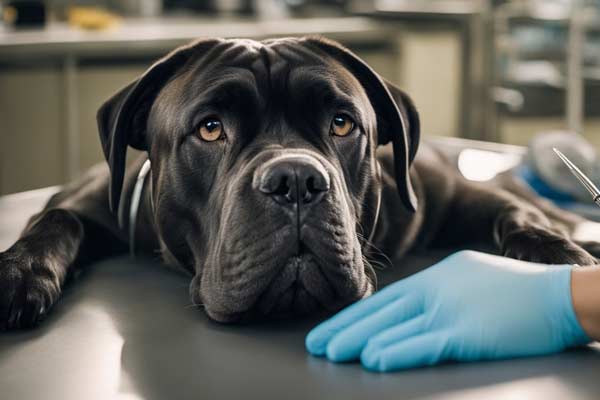Spaying and neutering are common medical procedures for animals, such as the Cane Corso breed of dogs, aimed at removing their reproductive organs.
Spaying, also known as ovariohysterectomy, involves removing the ovaries and uterus in female dogs. Neutering, or castration, is the procedure that removes the testicles in male dogs.
Spaying or neutering a Cane Corso can have several benefits, including reducing the risk of specific health problems, such as reproductive cancers.
It can also help prevent unwanted litter and reduce behavioral problems like aggression and roaming.
The spay and neuter procedures are typically performed under general anesthesia and involve making an incision in the dog’s abdomen or scrotum.
The surgery typically lasts between 30 minutes and an hour, and the majority of dogs can return home on the very same day.

Although spaying and neutering offer numerous advantages, it’s important to consider the possible drawbacks and issues arising from the procedure.
These potential issues encompass bleeding, infection, and unfavorable reactions to anesthesia.
It is crucial to discuss these risks with a veterinarian and weigh them against the benefits before deciding to spay or neuter a Cane Corso.
The age at which to spay or neuter a Cane Corso can vary depending on several factors, including the dog’s size, health, and breed.
Some veterinarians recommend spaying or neutering at around six months, while others suggest waiting until the dog is fully grown.
Consulting a veterinarian is crucial for determining the optimal timing to spay or neuter a Cane Corso.
When to Spay or Neuter a Cane Corso
Spaying or neutering a Cane Corso is a common practice that has numerous benefits for both the dog and its owner. However, the question of when to spay or neuter a Cane Corso is debated among veterinarians and dog owners.
According to the American Kennel Club, spaying or neutering a dog at four to six months of age is common practice.
However, recent studies have shown that there may be better ages to spay or neuter a Cane Corso. Waiting until the dog reaches puberty, around eight months of age, maybe more beneficial.
Some veterinarians recommend spaying or neutering a Cane Corso at 18 months or two years of age.
This is because waiting until the dog is fully grown can reduce the risk of specific health problems, such as joint issues, and can also have a positive impact on the dog’s behavior.
It’s crucial to remember that the decision on when to spay or neuter a Cane Corso should be determined individually, with input from a vet.
The right timing for this procedure will be influenced by factors like the dog’s age, health, and behavior.
Benefits of Spaying or Neutering Your Cane Corso
Spaying or neutering your Cane Corso can have several benefits, both for your pet’s health and behavior.

Here are some of the benefits of spaying or neutering your Cane Corso:
Health Benefits
Spaying or neutering your Cane Corso can greatly lower the chances of specific cancers, like breast cancer and reproductive system cancers.
For female Cane Corsos, spaying can also eliminate the risk of pyometra, which is a severe uterine infection that can be life-threatening.
Behavioral Benefits
Spaying or neutering your Cane Corso can also have behavioral benefits. Neutered or spayed dogs tend to be less aggressive and less likely to roam, which can reduce the risk of accidents and injuries.
Additionally, neutered or spayed dogs are less likely to mark their territory or exhibit other undesirable behaviors related to their reproductive organs.
Other Benefits
Opting to spay or neuter your Cane Corso carries a range of benefits, such as mitigating the risk of overpopulation and preventing unwanted litter. Moreover, it contributes to your Cane Corso’s longevity and overall health.
The timing of this procedure is critical. Some studies indicate that early spaying or neutering may increase the likelihood of specific health issues, including joint problems.
It’s generally recommended to wait until your Cane Corso is at least one year old before considering this surgery. However, it’s vital to consult with your veterinarian to determine the most suitable timing for your pet.
Potential Risks and Complications
Spaying or neutering your Cane Corso is a usual practice with many benefits, like lowering the chances of certain cancers and curbing undesirable behaviors. However, it’s essential to know that there are potential risks and issues involved.
One common risk is the possibility of infection, either at the surgical site or in the urinary tract. To prevent this, it’s crucial to maintain good hygiene and watch for any signs of discomfort or fever in your dog.
Another potential complication is bleeding, particularly if the dog isn’t adequately supervised during and after the procedure. In rare instances, excessive bleeding may require a blood transfusion.
Recovery time is also a consideration. Dogs may experience pain, discomfort, and lethargy for several days after the procedure.
Owners should follow their veterinarian’s instructions for post-operative care and monitor their dogs closely for any signs of complications.
Joint disorders, such as hip dysplasia and cruciate rupture, are also a concern for owners of large breed dogs like the Cane Corso.
Studies have shown that early spaying or neutering can increase the risk of these disorders, so owners should consider waiting until their dog is at least 18 months to 2 years old before proceeding with the procedure.
Spayed female dogs can experience problems like urinary incontinence and urinary tract infections.
To monitor your dog’s urinary health, owners must observe their pet’s bathroom habits and promptly inform their veterinarian if they notice any unusual changes.
Impact on Behavior and Temperament
Spaying or neutering Cane Corso can impact their behavior and temperament. According to a study, spaying and neutering can cause a 31% increase in fearfulness and a 33% increase in touch sensitivity.
However, it is important to note that this is not always the case, and the effects can vary from dog to dog.
Furthermore, spaying or neutering a Cane Corso at an inappropriate time frame can also lead to behavior issues such as aggression.
It is recommended to neuter or spay a Cane Corso between six and eighteen months of age, but most pet parents decide to do it around month nine.
The behavior and temperament of a Cane Corso can be greatly influenced by socialization and training.
When these dogs are properly socialized at a young age, it can reduce their likelihood of becoming aggressive and make training easier.
It’s essential to introduce them to various people, animals, and settings to help them develop strong social skills.
Considerations for Male and Female Cane Corso
When it comes to spaying or neutering a Cane Corso, there are some considerations to keep in mind for both male and female dogs. Here are some important points to consider:
Male Cane Corso
Neutering, which is the surgical removal of a male Cane Corso’s testicles, is a standard procedure. It is carried out primarily to prevent accidental breeding and to decrease the chances of certain health complications.
A critical consideration for male Cane Corsos is timing. Neutering too early can lead to potential health risks, such as an increased risk of bone cancer and joint problems.
On the other hand, waiting too long to neuter can lead to behavioral issues, such as aggression and marking.
It’s commonly advised to have male Cane Corsos neutered when they are between 6 and 18 months old. Doing this helps the dog reach full maturity and lowers the chances of health problems.

Female Cane Corso
Spaying a female Cane Corso, also known as a Cane Corso spay, involves the surgical removal of the ovaries and uterus.
This procedure is commonly done to prevent unintended breeding and to decrease the risk of specific health concerns. Timing is also an essential consideration for female Cane Corsos.
Spaying too early can lead to potential health risks, such as an increased risk of urinary incontinence and bone cancer. Waiting too long to spay can lead to behavioral issues, such as aggression and roaming.
It is generally recommended to spay female Cane Corsos between 4 and 9 months of age before their first heat cycle.
Performing spaying before a female pet’s first heat cycle can lower the chances of developing specific health issues, like mammary gland tumors.
If a female Cane Corso is already pregnant or nursing, spaying should be postponed until after the puppies are weaned.
It is also important to note that spaying does not affect a dog’s ability to protect or guard their family.
The Role of the Veterinarian
When spaying or neutering a Cane Corso, the veterinarian plays a crucial role in ensuring the procedure is done safely and effectively.
It is important to choose a reputable veterinarian with experience with the breed and the procedure.
The vet will first check if the dog is healthy enough for surgery through a physical examination.
They’ll also give necessary vaccinations and medications to prepare the dog. In the surgery, the vet will cut to remove the reproductive organs.
After the surgery, the vet will give instructions for taking care of the dog, which includes managing pain and limiting activity.
They’ll also set up follow-up appointments to check the dog’s recovery and ensure no issues.
Pet owners must have open communication with their vet and ask any questions about the procedure. The vet can advise on the right time to spay or neuter a Cane Corso based on the dog’s health and behavior.
Post-Surgery Care and Recovery
After a Cane Corso has been spayed or neutered, it is important to provide proper post-surgical care and recovery to ensure a successful healing process.
The recovery period typically lasts 10-14 days, during which the dog should be closely supervised and kept as quiet as possible to avoid running, jumping, and excessive playing.
One of the most essential aspects of post-surgery care is monitoring the dog’s food intake and ensuring they maintain a healthy weight.
Overweight or obese dogs may experience complications during the recovery period, so it is crucial to follow the veterinarian’s instructions regarding feeding and exercise.
During the first few days after surgery, the dog may experience some discomfort and may not have much of an appetite.
It is important to provide small, frequent meals to prevent nausea and vomiting. Soft, easily digestible food is recommended during this time.
Aside from keeping an eye on the dog’s food consumption, it’s vital to create a cozy and secure environment for their recovery.
Ensure the dog stays in a quiet, warm, dry space with limited activity and stimulation. Soft bedding and a warm blanket will offer comfort during this period.
Exercise should be limited during the recovery period to prevent any strain on the surgical site.
Short-leash walks are recommended to promote circulation and prevent blood clots. However, strenuous exercise or activities should be avoided until the veterinarian gives the green light.
The Debate on Spaying and Neutering
The topic of spaying and neutering dogs is a controversial one, with varying opinions on the best age to do it and whether it should be done at all.
Some people who raise and care for dogs think it’s important to spay or neuter them, but others say it could harm their health and behavior.
Research on the subject is ongoing, with studies showing both positive and negative effects of spaying and neutering.
The American Kennel Club (AKC) recommends spaying or neutering dogs at six months of age but acknowledges that the decision should be made on a case-by-case basis.
Spaying and neutering are often promoted to prevent unwanted litters and decrease the number of dogs in shelters.
Nonetheless, some breeders argue that these procedures can harm the health and behavior of purebred dogs.
They believe that responsible breeding practices can achieve the same goal of reducing the number of unwanted dogs.
Therefore, breeders and dog owners should thoughtfully evaluate the benefits and drawbacks of spaying or neutering their dogs. They should then make a well-informed decision that aligns with their circumstances.
While there are definite advantages to spaying and neutering, such as reducing the risk of health issues and preventing unexpected litter, it’s not a one-size-fits-all solution and should be thoughtfully considered.
